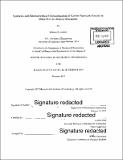Synthesis and electrochemical characterization of carbon nanotube forests on metal foils for battery electrodes
Author(s)
Lettiere, Bethany Rose
DownloadFull printable version (11.16Mb)
Alternative title
Synthesis and electrochemical characterization of CNT forests on metal foils for battery electrode
Other Contributors
Massachusetts Institute of Technology. Department of Mechanical Engineering.
Advisor
A. John Hart.
Terms of use
Metadata
Show full item recordAbstract
Lithium ion batteries (LiBs) are attractive because of their light weight, large specific energy and long cycle life. Lithium ion batteries are typically a planar design where electrode films are manufactured on metal foils and assembled with an ion-conducting separator. The short diffusion length between electrodes in these thin film configurations increases the power density, but reduces the energy density per footprint. There is a need for increasing energy density per footprint to allow for device minimization. 3-dimensional (3D) batteries offer a solution to this problem by creating battery electrodes that have active materials configured perpendicular to the footprint of the material instead of expanding the footprint. This thesis presents the synthesis and initial testing of a carbon nanotube (CNT)-based electrode in a LiB towards the development of 3D microbatteries with high energy density per areal footprint. Microcontact printing is also explored as a scalable method to pattern CNT catalyst. In this thesis, the CNT-based electrode is fabricated by growing vertically aligned CNTs on a copper foil using chemical vapor deposition, and depositing the active material, iron phosphate (FP), conformally onto the CNTs using atomic layer deposition (ALD). The CNTs are grown on a multilayer catalyst-support structure consisting of an iron catalyst and alumina/tungsten support layer. This structure is shown to hinder the diffusion of copper into the substrate surface and yields uniform CNT growth. Conformal coating is achieved on the CNTs by optimizing the ALD recipe. The battery is fabricated using a coin cell using the CNT/FP as the cathode and lithium foil as the counter electrode. The coin cell is measured to have a specific capacity of 17mAh/g, and an areal capacity of 0.035 mAh/cm2 at C/10. Future work will include investigation of the performance of the electrode and bare CNTs electrodes for longer cycles at higher rates for the constructed LiB, and the effects of FP thickness and CNT height on the areal power and capacity density. We will also study the electrical contact between the CNTs and the copper foil. In addition, we will work on the development of concepts for fully 3D CNT-based batteries, e.g. micropatterned CNTs and interdigitated electrodes.
Description
Thesis: S.M., Massachusetts Institute of Technology, Department of Mechanical Engineering, 2017. Cataloged from PDF version of thesis. Includes bibliographical references (pages 63-67).
Date issued
2017Department
Massachusetts Institute of Technology. Department of Mechanical EngineeringPublisher
Massachusetts Institute of Technology
Keywords
Mechanical Engineering.